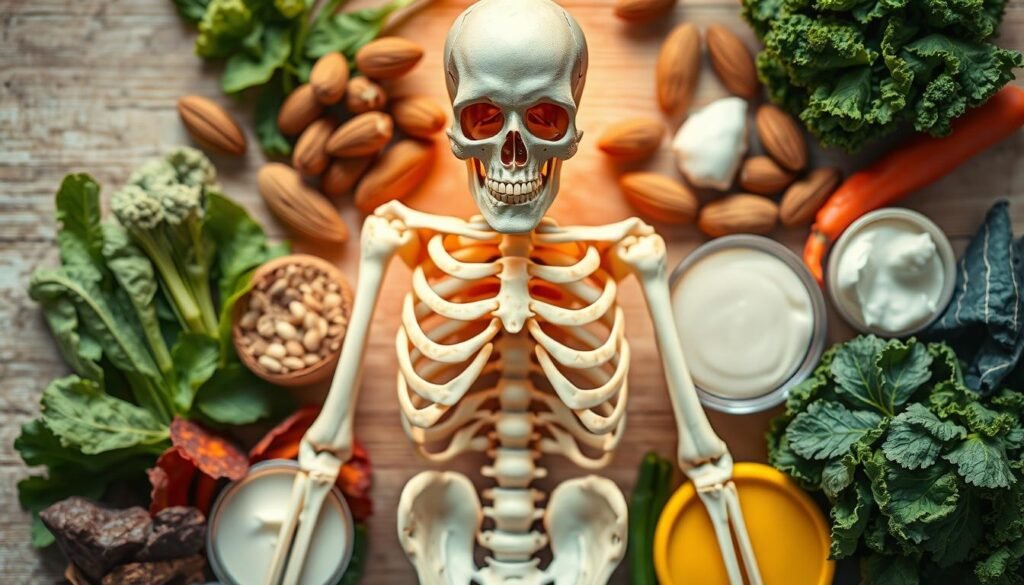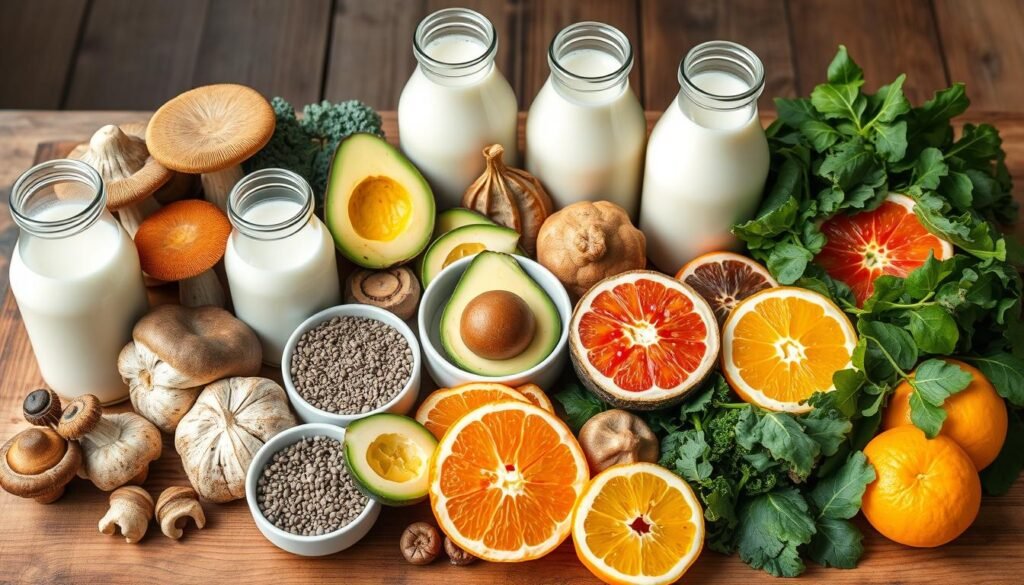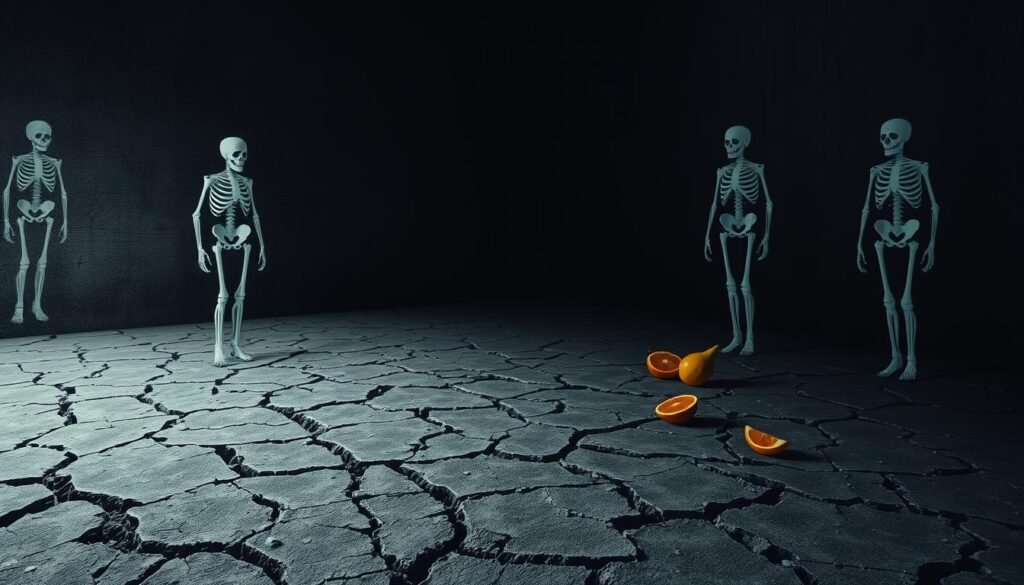Did you know nearly 42% of Americans don’t get enough vitamin D? This fact shows how vital it is to understand where to get this key nutrient. Vitamin D is crucial for bone health, helping our bodies use calcium. Getting enough vitamin D can make bones stronger and lower the risk of osteoporosis. It’s important to know which foods are rich in vitamin D and add them to our meals.
Fatty fish, fortified dairy, and certain plants are great for getting enough vitamin D. Also, sunlight can help our bodies make vitamin D. But, eating the right foods is key, especially if you don’t spend much time in the sun. A diet with plenty of vitamin D helps keep bones strong and supports overall health.
Learn more about dietary sources for strong bones and why vitamin D is important
Key Takeaways
- Nearly 42% of Americans are vitamin D deficient, stressing the need for awareness.
- Vitamin D helps the body absorb calcium, crucial for maintaining bone health.
- Fatty fish, fortified dairy, and certain plant-based foods are excellent sources of vitamin D.
- Regular sun exposure can aid in producing vitamin D but should be complemented with dietary sources.
- Incorporating vitamin D rich foods into daily meals supports overall wellness and bone strength.
Understanding the Importance of Vitamin D for Bone Health
Vitamin D is key for optimal bone health. It helps our bodies use calcium, which makes our bones strong. Without enough vitamin D, people can get sick with things like rickets or osteoporosis. These problems show us how crucial vitamin D is for our bones and muscles.
Different age groups need different amounts of vitamin D. Babies up to a year old need 400 IU each day. Kids and adults up to 70 years should get 600 IU. People older than 70 need 800 IU a day to keep their bones strong.
Taking enough vitamin D and calcium can help slow down bone loss. This can lower the chance of getting fractures. Studies prove that getting enough of these nutrients helps avoid issues like osteoporosis. But, too much vitamin D can be harmful. For kids 9 years and older, taking more than 4,000 IU can cause nausea and weakness.
It’s crucial to keep vitamin D levels healthy to avoid bone problems. To improve optimal bone health, people should eat foods rich in vitamin D. Sometimes, supplements might be needed. For more tips on vitamins for strong bones, check this resource.
What Foods Have Vitamin D?
Vitamin D is key for strong bones and overall health. It’s smart to pick foods that boost vitamin D, especially if you don’t get much sun. This part talks about natural sources of vitamin D and fortified foods with vitamin D. These can help you get enough.
Natural Sources of Vitamin D
Some foods are rich in vitamin D. They are good for your diet. Important sources include:
- Fatty Fish: Salmon has 10 to 18 mcg of vitamin D per 3-ounce serving. For example, Atlantic salmon has around 526 IU, which is 66% of what you need daily.
- Rainbow Trout: This fish has up to 16 mcg per serving. It’s good for bone health.
- Egg Yolks: One big egg yolk has about 37 IU. It adds to your daily vitamin D.
- Portabella Mushrooms: A 3-ounce serving has about 8 mcg of vitamin D if it’s sun-kissed.
Fortified Foods with Vitamin D
Fortified foods are a big help in getting enough vitamin D. They’re especially important if you don’t get enough sun.
- Dairy Products: Cow’s milk usually offers about 3 mcg of vitamin D per cup. You get the same from yogurt per 8-ounce serving.
- Plant-Based Milk Alternatives: Drinks like soy milk and almond milk often have about 2.5 to 3 mcg per cup.
- Breakfast Cereals: Many cereals add vitamin D. It’s a simple way to increase your intake.
- Fortified Orange Juice: A cup gives you around 2.5 mcg of vitamin D. It’s perfect with breakfast.
Using these foods makes meals tastier and boosts your vitamin D. For more on the best vitamin D food list, look at this detailed guide.
Top Vitamin D Rich Foods to Include in Your Diet
Adding top vitamin D rich foods into your daily meals boosts bone health. A variety of foods offer different benefits. It’s important to include many options that are high in vitamin D.
Fatty Fish as Key Players
Fatty fish are great for getting vitamin D. Wild-caught salmon and mackerel have high amounts. Just 1-ounce of salmon gives you up to 190 IU, depending on the fish. Sardines add 55 IU per ounce, too.
The benefits of fatty fish go beyond vitamin D. They’re also full of omega-3 fatty acids for a healthy heart. A serving of rainbow trout has an impressive 645 IU of vitamin D.
Egg Yolks and Their Benefits
Egg yolks are another good vitamin D source. Though they have less vitamin D than fish, they still are nutritious. Each yolk gives around 37 IU of vitamin D. They also offer proteins and fats important for health.
Adding egg yolks to your diet is a tasty way to get more vitamin D.
Fortified Dairy Products and Alternatives
Dairy products help keep bones healthy. A cup of low-fat milk provides about 117 IU of vitamin D. Plain nonfat yogurt is also good, with 116 IU in an 8-ounce serving.
For those preferring plant-based options, almond milk and soy milk are fortified. Unsweetened soy milk has 119 IU per cup. Fortified almond milk gives about 107 IU. Plus, fortified orange juice has 100 IU per cup, great for breakfast.
| Food Source | Serving Size | Vitamin D Content (IU) |
|---|---|---|
| Rainbow Trout | 3 ounces | 645 |
| Wild-Caught Salmon | 1 ounce | 128-190 |
| Sardines, Canned | 1 ounce | 55 |
| Egg Yolk | 1 yolk | 37 |
| Low-Fat Milk | 1 cup | 117 |
| Plain Nonfat Yogurt | 8 ounces | 116 |
| Soy Milk, Unsweetened | 1 cup | 119 |
| Almond Milk, Fortified | 1 cup | 107 |
| Fortified Orange Juice | 1 cup | 100 |
The Role of Calcium in Bone Health
Calcium is crucial for strong bones and overall health of the skeleton. If we don’t get enough calcium, our bones can get weak and might break easily. Knowing how much calcium we need every day helps people of all ages keep their bones strong throughout their lives.
Why Calcium is Essential
Calcium’s role is key to our bone health. It’s vital for keeping bones dense and strong. Also, getting enough calcium reduces the risk of osteoporosis later on. The best sources are milk and dairy, as they’re rich in calcium.
Other good sources include salmon, sardines, almonds, and green leafy vegetables. Cooking these veggies with little water keeps more calcium in them. This makes these foods even better for your bones.
Daily Calcium Requirements
Daily calcium needs change with age and sex. Here is what is recommended:
| Age Group | Calcium Requirement (mg) |
|---|---|
| Females and Males 9 to 18 years | 1,300 |
| Women and Men 19 to 50 years | 1,000 |
| Women 51 to 70 years | 1,200 |
| Men 51 to 70 years | 1,000 |
| Women and Men over 70 years | 1,200 |
| Pregnant or Nursing Women (14 to 18 years) | 1,300 |
| Pregnant or Nursing Women (19 to 50 years) | 1,000 |
Many Americans don’t get enough calcium, leading to lower bone density and more fractures. If you’re not getting enough, talking to a doctor about supplements could help. For in-depth advice on calcium and vitamin D, check out this link.

How Vitamin D Enhances Calcium Absorption
Vitamin D and calcium work together to keep us healthy. Vitamin D helps our intestines absorb calcium, which we need for strong bones. Without enough vitamin D, our bodies can’t get enough calcium from our food. This can lead to weak bones as we get older.
For the best calcium absorption, you need a certain level of vitamin D in your blood. However, many people in the U.S. don’t have enough vitamin D. Over 61% of white Americans and 92% of black Americans don’t have enough vitamin D. It’s critical to understand how calcium and vitamin D work together for our bones.
People with low vitamin D can’t absorb calcium well. This can cause bone problems. It’s really important for people, like postmenopausal women, to get enough vitamin D. Over half of them don’t have enough vitamin D.
In short, vitamin D is key for using calcium to make our bones strong. To have healthier bones, we should ensure we have enough vitamin D. This makes our bones stronger and keeps our body healthier overall.
Great Options for Vegans and Vegetarians
For those living vegan or vegetarian, getting enough vitamin D can be tricky. Yet, with smart meal planning, you can include vegan vitamin D foods and vegetarian sources of vitamin D in your diet. Here are some great choices for both eating plans.
Vegan Vitamin D Foods
Plenty of plant-based foods have vitamin D added to them. This helps vegans keep their vitamin D at good levels. See some key examples below:
- Fortified Soy Milk: Has about 2.9 mcg (116 IU) of vitamin D in each cup.
- Fortified Almond Milk: Provides roughly 2.4 mcg (96 IU) of vitamin D per cup.
- Fortified Rice Milk: Also offers about 2.4 mcg (96 IU) of vitamin D per cup.
- Mushrooms: Mushrooms hit by UV light may have up to 450 IU of vitamin D per 100 grams.
- Fortified Breakfast Cereals: They often have between 0.2 to 2.5 mcg (8 to 100 IU) of vitamin D per bowl.
- Fortified Orange Juice: Can contain as much as 2.5 mcg (100 IU) of vitamin D per glass.
Vegetarian Sources of Vitamin D
Vegetarians have additional vitamin D options, including:
- Egg Yolks: They’re a direct source of vitamin D and boost your daily intake.
- Fortified Dairy Products: Items like milk, yogurt, and cheese are often fortified with vitamin D. They help with your nutrition.
Eating balanced meals is key for vegans and vegetarians to get enough vitamin D. Adding these vegan vitamin D foods and vegetarian sources of vitamin D can lower the risk of not having enough vitamin D. This is important because about 42 percent of adults in the U.S. might not have enough vitamin D.

| Food Source | Vitamin D Content (mcg/IU) | Type |
|---|---|---|
| Fortified Soy Milk | 2.9 mcg (116 IU) | Vegan |
| Fortified Almond Milk | 2.4 mcg (96 IU) | Vegan |
| Fortified Rice Milk | 2.4 mcg (96 IU) | Vegan |
| UV-Exposed Mushrooms | 450 IU per 100 grams | Vegan |
| Fortified Breakfast Cereals | 0.2 to 2.5 mcg (8 to 100 IU) | Vegan |
| Fortified Orange Juice | 2.5 mcg (100 IU) | Vegan |
| Egg Yolks | Varies | Vegetarian |
| Fortified Dairy Products | Varies | Vegetarian |
The Impact of Sunlight on Vitamin D Levels
Sunlight is key to keeping vitamin D levels right in our bodies. When our skin gets UVB rays, it turns 7-dehydrocholesterol into previtamin D3. This then becomes active vitamin D. This sun exposure vitamin D production is crucial for our health. Yet, where you live, the time of year, and your skin color can affect it.
How Sun Exposure Affects Vitamin D Production
Where you live and the weather play big roles in making vitamin D. People far up North get less sun in winter. This leads to more people not having enough vitamin D. Studies show that in Northern Europe and parts of the Northeastern U.S., lots of kids had signs of rickets.
People with darker skin need more sun to get the same vitamin D as those with lighter skin. This means folks in sunny, southern U.S. states usually have enough vitamin D in winter. But, people up North might not.
Sunlight Recommendations
How much sun you need depends on your skin color and where you live. Usually, lighter-skinned folks need about 13 minutes of midday sun several times a week in summer. Those with darker skin may need up to three hours.
But, it’s important to protect your skin from too much sun. Too much can burn your skin and up your cancer risk. Sunscreen cuts down vitamin D creation but might not affect your overall level in summer too much.
Here’s a quick look at sun time advice:
| Skin Type | Recommended Sun Exposure |
|---|---|
| Light Skin | 13 minutes, 3 times a week in summer |
| Medium Skin | 20-30 minutes, 3 times a week in summer |
| Dark Skin | 30 minutes to 3 hours, 3 times a week in summer |
Safe sun habits are good for your vitamin D levels without the risks. If you can’t get enough vitamin D from the sun, think about using supplements or eating fortified foods.
Risks of Vitamin D Deficiency
Vitamin D deficiency is more than just feeling tired. It can cause big health problems, especially for your bones. If you don’t have enough vitamin D, you might face issues. These include osteoporosis, where your bones get very fragile.
And osteomalacia, that makes your bones’ mineral structure weak. Also, with not enough vitamin D, you can get sick more easily. This is because it’s key for a strong immune system.
Consequences of Low Vitamin D
It’s key to know the downsides of not enough vitamin D. Not having enough can lead to mild, moderate, or severe issues. The worse it gets, the less vitamin D you have. You might just feel aches at first, but then bone pain kicks in.
If it gets really bad, children can get rickets, and older folks might break bones easier. Keeping vitamin D levels up is important. You want them above 20 nanograms per milliliter for good health.
Groups at Higher Risk for Deficiency
Some people are more likely to lack vitamin D. Older adults don’t make vitamin D from sunlight as well. And, folks with darker skin have a harder time too.
If you don’t see much sun, you could be at risk as well. With a big portion of U.S. adults lacking vitamin D, it’s smart to eat foods rich in it. And maybe take supplements if you need to.

How to Boost Your Vitamin D Intake
It’s important to increase vitamin D in our bodies for good health, bone strength included. We can do this by eating certain foods high in vitamin D. By choosing the right foods and supplements, we can boost our vitamin D levels.
Dietary Strategies
Here are some ways to up your vitamin D:
- Include fatty fish: Salmon, mackerel, and sardines are packed with vitamin D.
- Opt for fortified foods: Choose cow’s milk, plant-based milk, orange juice, yogurts, and cereals with extra vitamin D.
- Incorporate egg yolks: They have some vitamin D, especially if the chickens are pasture-raised.
- Mushrooms: Look for types exposed to UV light; they have lots of vitamin D.
When to Consider Supplements
Some people don’t get enough vitamin D from their diet, especially in winter or if they don’t see much sunlight. The U.S. National Academy of Medicine says adults need 600–800 IU of vitamin D daily. The U.S. Endocrine Society suggests more for the best health. Supplements might help in these cases.
Here’s what’s recommended:
- Adults and kids over 4 should take 10 micrograms (400 IU) in the darker months if they aren’t outside much.
- Breastfed babies and young kids need 8.5 to 10 micrograms of vitamin D all year.
- Think about using vitamin D3 supplements. They’re great for increasing vitamin D in your blood.
| Supplement Type | Recommended Dosage | Source |
|---|---|---|
| Vitamin D2 | 800 IU daily | Commonly found in fortified foods |
| Vitamin D3 | 1,000 – 4,000 IU daily | Recommended for most people |
| Cod Liver Oil | 1 tablespoon (1,300 IU) | High potency source |
Conclusion
Vitamin D is crucial for strong bones. Eating foods rich in vitamin D, like oily fish, fortified dairy, and certain mushrooms, helps. If you don’t get enough sun, these foods are key to prevent vitamin D deficiency and boost wellness.
It’s also important to know how vitamin D and calcium work together for bone strength. Eating right, getting some sun, and maybe taking supplements can help meet vitamin D needs. This approach helps keep bones healthy.
Making smart food and lifestyle choices leads to better bone health and life quality. Start by adding a variety of vitamin D-rich foods to your diet. This is the first step to having stronger bones and a brighter future.